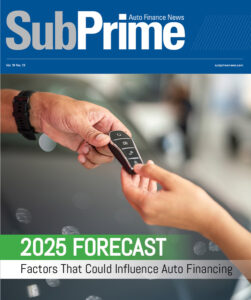TransUnion: 60-Day Auto Loan Delinquency Rate to Hit 1% by Year-End
CHICAGO — While TransUnion.com reported that there was a drop in the average first-quarter 60-day auto loan delinquency rate throughout the nation, the company attributed this more to seasonal patterns than a reversal of trends related to the auto lending environment.
"As in recent quarters, both the availability of funding (liquidity crisis) in the market for auto loans and tighter lending standards have significantly decreased the number of auto loans in the market, putting continued upward pressure on delinquency rates," officials explained.
More specifically, the national 60-day auto delinquency rate declined slightly quarter over quarter, 0.86 percent to 0.86 percent.
However, the year-over-year delinquency rate jumped 27.69 percent in the first quarter, according to TransUnion.com.
Looking at various states, average auto loan delinquency came in highest in Mississippi at 1.49 percent, followed by Louisiana at 1.40 percent.
Meanwhile, the lowest auto-loan delinquency rates were found in South Dakota (0.34 percent), North Dakota (0.35 percent) and Wyoming (0.44 percent).
As for the largest improvements over the prior quarter, these appeared in South Dakota (45.16 percent decrease from 0.62 percent) and Vermont (33.3 percent decrease from 0.99 percent).
Continuing on, TransUnion.com indicated that auto debt nationally continued to decrease slightly in the first quarter from $12,713 to $12,596.
Likewise, year-over-year auto debt fell by 1.85 percent. The state with the largest auto debt burden was Nevada at $15,080, followed by Texas at $14,748. The lowest average auto debt was in Nebraska at $10,629.
Also, the company found that the steepest annual increases in average auto debt, as a percentage, occurred in Michigan (up 1.49 percent), New Jersey (up 1.38 percent) and Rhode Island (up 0.48 percent), while South Dakota experienced the sharpest drop in annual average auto debt (down 4.61 percent) followed by Utah (down 3.38 percent).
Furthermore, on a state-level basis, 27 states experienced a drop in their quarter-to-quarter delinquency rates, whereas only one (South Dakota) showed a drop on a year-over-year basis.
"It is interesting to note the deteriorating risk environment has now affected even Alaska, which at the end of last year showed an extremely low auto delinquency rate of 0.19 percent. In the first quarter of 2008 Alaska's delinquency rate increased by 247 percent quarter-to-quarter and 78 percent on a year-over-year basis, the largest increase for 2009," TransUnion.com reported.
Offering some insight, Peter Turek, TransUnion's automotive vice president, said, "At the end of the 2001 recession, the national auto delinquency rate increased to a high of just over 1 percent, and then began to edge downward for the next four or five years.
"As the recession came to a close in November of 2001, three of the five riskiest cities in the country were found in Texas: El Paso (5 percent), McAllen (2.46 percent) and Laredo (2.09 percent). In our current recession, Laredo is still leading in terms of auto delinquency (3.08 percent), but now is followed closely by metropolitan areas within the state of California such as Visalia (2.33 percent), reflecting the impact of the housing market on that state's economy," he continued.
"Today, the least risky metropolitan area is Corvallis, Ore., which shoulders an almost zero auto delinquency rate, a position consistent with what it held during the previous recession," Turek added.
Looking ahead, he said the company's forecast for the first quarter was "short by about 2 percent, as a slightly more favorable vision of the economic environment prompted some downward revisions to our forecast through the end of the year."
"Our current forecasting models indicate that the national 60-day auto delinquency rate will rise to about 1 percent by year-end, about the same level as that experienced at the end of our last recession," Turek noted.
"However, the overall economy, weak labor market and lower disposable income levels will continue to negatively impact the consumer well into 2010," he highlighted.
At the state level, Mississippi is still anticipated to experience the highest delinquency rate by fourth quarter of 2009 at 1.94 percent, while South Dakota should prove to have the lowest level of auto delinquency at 0.44 percent, the company predicted.
Snapshot of overall credit trends:
— Mortgage loan delinquency (the ratio of borrowers 60 or more days past due) increased for the ninth straight quarter, hitting a national average high of 5.22 percent for the first quarter of 2009. Traditionally seen as a precursor to foreclosures, this statistic is up almost 14 percent from the previous quarter's 4.58 percent average. This compares to an increase of 16 percent from the third to fourth quarter of 2008. Year-over-year, mortgage loan delinquency is up approximately 62 percent (from 3.23 percent).
— The average national mortgage debt per borrower rose again (1.41 percent) to $195,500 from the previous quarter's $192,789. On a year-over-year basis, the first quarter 2009 average represents a 1.87-percent increase compared to the first quarter 2008 average of $191,917.
— Average bankcard borrower debt (defined as the aggregate balance on all bank-issued credit cards for an individual bankcard borrower) inched upward nationally 0.82 percent to $5,776 from the previous quarter's $5,729, and 4.09 percent compared to the first quarter of 2008 ($5,548).
— Nationally, the bankcard delinquency rate (the ratio of bankcard borrowers 90 days or more delinquent on one or more of their bankcards) increased to 1.32 percent in the first quarter of 2009, up 9.1 percent over the previous quarter. Year-over-year, bankcard delinquencies increased 11 percent from 1.19 to 1.32 percent.

 View The Latest Edition
View The Latest Edition

